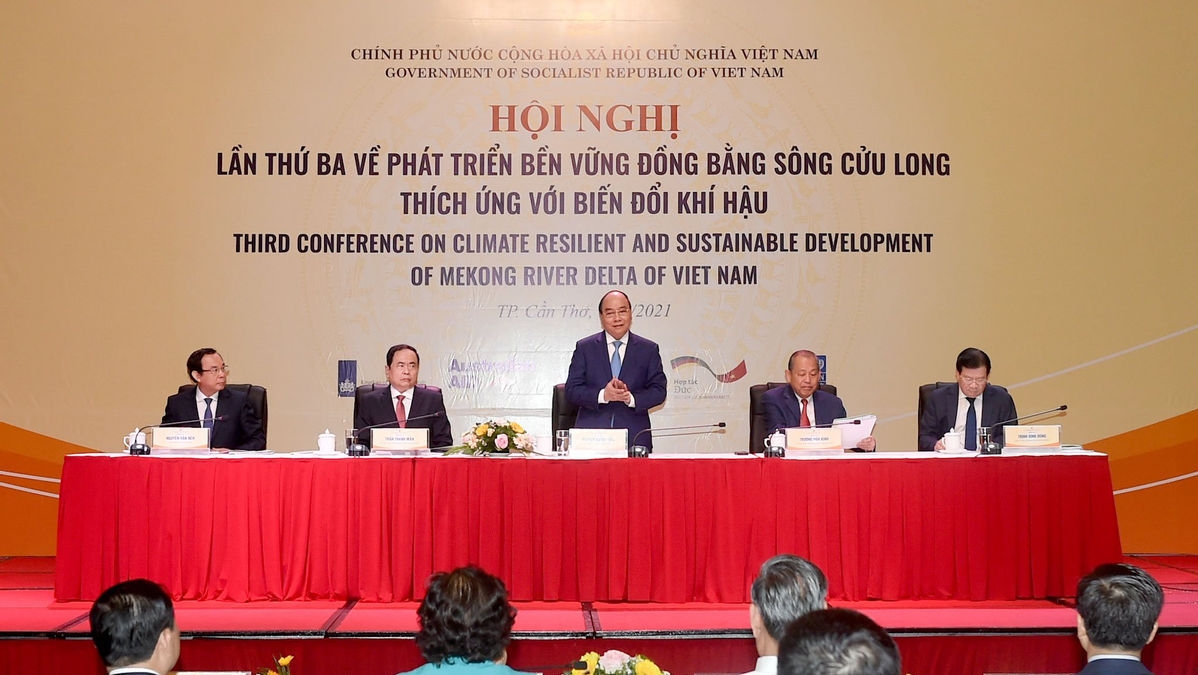Prime Minister Nguyen Xuan Phuc talked about a new strategic viewpoint involving eight “Gs” on the development of the Mekong Delta while chairing a conference in Can Tho city on March 13.
On November 17, 2017, the Government issued Resolution 120/NQ-CP on sustainably developing the Mekong Delta in adaptation to climate change, which sets up goals for 2050 and a vision to 2100.
At the conference – the third of its kind on sustainably developing the Mekong Delta in adaptation to climate change, PM Phuc highlighted this region as the agricultural hub of Vietnam, which contributes to 50 percent of the total unhusked rice output, 95 percent of the rice export volume, 65 percent of the aquacultural output, and 70 percent of the fruit production.

At the conference (Photo: congly.vn)
He said despite initial encouraging outcomes in the resolution implementation, ministries, sectors, and localities do not be complacent but must be aware that there are a large number of tasks for the time ahead.
Mentioning the “8G” viewpoint on the Mekong Delta’s development, the PM said the first “G” is “giao thong” (traffic), elaborating that resources must be prioritised for developing the traffic system to facilitate travel and economic activities.
The second “G” is “giao duc” (education), which he described as the “golden key” to sustainable development.
Meanwhile, the third is “giang” (rivers), he noted, adding that development strategies should make use of local rivers to promote agriculture and aquaculture as well as waterway traffic and logistics, and that there should be a study of river-based economic activities.
PM Phuc also pointed out the necessity of “gan” (connecting), which means connecting central agencies with localities, people with businesses, domestic parties with international organisations, and especially, connecting together the 13 provincial-level localities in the Mekong Delta.
In his remarks, the Government leader also recommended the localities attract “giau” (rich) and “gioi” (talented) people who will contribute to local development.
Besides, “gia” (ageing) is now a challenge to the Mekong Delta, where the speed of population aging is faster than the national average, he added, asking for proactive policies on this issue.
The last “G” is “gioi” (gender), PM Phuc went on, underlining the importance of enhancing gender equality, boosting women’s access to job opportunities, and brining into play their role.
At the conference, Minister of Natural Resources and Environment Tran Hong Ha reported that after over three years of implementing Resolution 120/NQ-CP, the Mekong Delta has recorded strong changes with improvements in both mindset and action, proactive moves to adapt to climate change, and people enjoying better livelihoods and living standards.
The region has continually posted high economic growth, with an impressive rate of about 7.3 percent in 2018 and 2019, Minister Ha said.
World Bank Country Director for Vietnam Carolyn Turk considered Resolution 120 a breakthrough as it marked the change from passivity in the face of climate change to proactive adaptation to the nature.
This resolution pointed out that climate change, extreme weather, and saltwater intrusion have become the “new normal” of the Mekong Delta. It also provided the basis for shifting the region’s development model, from small-scale and provincial-level development to inter-provincial development, and from short-term and sectoral development to long-term, multi-sectoral, and integrated development, according to Turk.
The Mekong Delta is an illustration of the change in the Vietnamese Government’s mindset and approach to development, she said, affirming that the World Bank is ready to mobilise more knowledge and financial sources to help realise the visions and goals of Resolution 120.
The region consists of Can Tho city and the provinces of Long An, Tien Giang, Dong Thap, Vinh Long, Tra Vinh, Hau Giang, Soc Trang, Ben Tre, An Giang, Kien Giang, Bac Lieu, and Ca Mau.





